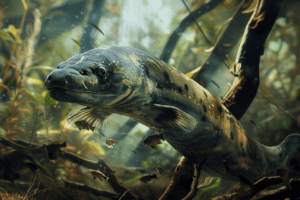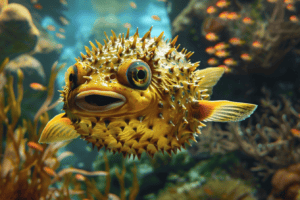Deep-sea creatures have always fascinated scientists and explorers alike.
The vast and mysterious depths of the ocean hold many secrets that are yet to be discovered.
One such enigmatic creature is the jellynose fish, found in the abyssal zone of the ocean.

The jellynose fish is a unique species that has adapted to survive in the extreme conditions of the deep sea.
With its bioluminescent organs and elongated snout, it is perfectly equipped to navigate the dark and cold waters.
Despite its strange appearance, very little is known about this deep-sea dweller.
Scientists are eager to learn more about this elusive species and the role it plays in the ecosystem.
In this article, we will delve into the abyss to uncover the mysteries of the jellynose fish.
We will explore its physical characteristics, behavior, and habitat.
We will also discuss the challenges scientists face in studying this elusive creature and the importance of understanding the deep sea ecosystem.
Get ready to embark on a fascinating journey into the unknown depths of the ocean!
Mysteries of the Deep

Habitats of the Jellynose Fish
The deep sea is a vast and mysterious place, with depths that can reach up to 36,000 feet.
It’s a world that is largely unexplored, and scientists are constantly discovering new species that call it home.
One such creature is the jellynose fish, a strange and elusive creature that lives in the depths of the ocean.
Jellynose fish are found in a variety of habitats, including the rocky slopes of underwater mountains and the soft sediment of the abyssal plain.
They are known to live in depths ranging from 1,000 to 6,000 feet, and are often found in areas with strong currents.
Despite their name, jellynose fish are not actually jellyfish.
They are a type of deep-sea fish that belong to the family Ateleopodidae, and are characterized by their long, slender bodies and distinctive snouts.
These snouts are covered in tiny sensory pores that help the fish locate prey in the dark, murky waters of the deep sea.
Physical Characteristics
Jellynose fish are unique in appearance, with long, slender bodies that are covered in tiny scales.
They have large, round eyes that are adapted to see in low light conditions, and their bodies are often a pale pink or yellowish color.
One of the most distinctive features of the jellynose fish is its snout, which is covered in tiny sensory pores that help the fish locate prey.
These pores are so sensitive that they can detect the electrical fields generated by other animals in the water.
Jellynose fish also have a unique reproductive strategy.
Instead of laying eggs, females carry their young inside their bodies until they are fully developed.
Once the young are born, they are able to swim and feed on their own.
Despite their strange appearance and elusive nature, jellynose fish play an important role in the deep-sea ecosystem.
They are a source of food for larger predators, and their unique adaptations allow them to survive in the harsh conditions of the deep sea.
Jellynose Fish Behavior

Feeding Patterns
Jellynose fish are known for their unique feeding habits. They have a long and slender snout that is used to detect prey buried in the sand or mud.
Once they locate their prey, they use their long and flexible jaws to suck it up like a vacuum cleaner.
Their diet consists of small crustaceans, worms, and other small fish.
They are also known to feed on detritus and other organic matter found on the ocean floor.
Due to the scarcity of food in the deep sea, jellynose fish have adapted to consuming a wide range of food sources.
Reproduction and Life Cycle
Jellynose fish have a slow reproductive rate and a long life span. They reach sexual maturity at around 5 to 7 years old, and can live up to 25 years.
They reproduce through external fertilization, which means the female releases eggs into the water and the male fertilizes them.
The eggs hatch into larvae, which then settle on the ocean floor and develop into juvenile fish.
Jellynose fish are not heavily targeted by commercial fisheries, but they are often caught as bycatch.
Due to their slow growth and reproductive rate, overfishing could have a significant impact on their population.
Fun Fact: Jellynose fish are known for their bioluminescent properties.
They have light-producing organs called photophores that help them attract prey and communicate with other jellynose fish in the dark depths of the ocean.
Human Interaction and Conservation

Discoveries and Research
Human interaction with deep-sea jellynose fish has been limited due to the extreme depths at which they live.
However, recent technological advancements have allowed for more exploration and research of these mysterious creatures.
Scientists have discovered that jellynose fish have a unique adaptation that allows them to survive in the harsh conditions of the deep sea.
They possess a special type of protein that prevents their cells from collapsing under the immense pressure of the ocean depths.
Additionally, researchers have found that jellynose fish play an important role in the deep-sea ecosystem.
They are a food source for larger predators and help to maintain a balance in the food chain.
Through studying their behavior and habitat, scientists hope to gain a better understanding of the complex web of life in the deep sea.
Conservation Efforts
Despite their importance in the ecosystem, jellynose fish face threats from human activities such as deep-sea mining and fishing.
To protect these unique creatures, conservation efforts are underway.
The International Union for Conservation of Nature (IUCN) has listed several species of jellynose fish as vulnerable or endangered.
To aid in conservation efforts, it is important for individuals to be aware of the impact of their actions on the deep-sea ecosystem.
This includes reducing plastic waste and supporting sustainable fishing practices.
By working together, we can help to ensure the survival of these enigmatic creatures for generations to come.
Fun Fact: Jellynose fish are named for their unique snout, which is covered in sensory organs that resemble jellybeans.
Frequently Asked Questions

What mysterious creatures dwell in the depths of the ocean?
The ocean is home to a vast array of creatures, many of which remain a mystery to us.
The deep-sea jellynose fish is just one example of the strange and fascinating creatures that live in the abyssal zone.
Other mysterious creatures that dwell in the deep sea include the anglerfish, the giant squid, and the vampire squid.
How do deep-sea creatures like the jellynose fish adapt to their dark environment?
The deep sea is an extreme environment, with high pressure, low temperatures, and no sunlight.
To survive in this environment, deep-sea creatures have evolved a range of adaptations.
The jellynose fish, for example, has large eyes that are adapted to low light levels, allowing it to see in the dark.
It also has a unique sensory system that allows it to detect electrical fields, which it uses to locate prey.
What are the characteristics of fish that inhabit the abyssal zone?
Fish that live in the abyssal zone have a number of adaptations that allow them to survive in this extreme environment.
They typically have large eyes that are adapted to low light levels, as well as a range of sensory adaptations that allow them to detect prey and navigate in the dark.
They also tend to have slow metabolisms, which allows them to conserve energy in the low food environment of the deep sea.
Can you name some of the strangest adaptations found in abyssal fish?
Abyssal fish have evolved some truly bizarre adaptations to life in the deep sea.
Some species have bioluminescent organs that they use to attract prey or communicate with other fish.
Others have long, thin bodies that allow them to move through the water with minimal resistance.
Some species have even evolved the ability to inflate their bodies like a balloon, which makes them more buoyant and helps them conserve energy.
How do scientists study the elusive species living in the deepest parts of the sea?
Studying deep-sea creatures is a challenging task, as they live in an environment that is difficult to access.
Scientists use a range of tools and techniques to study these elusive species, including remotely operated vehicles (ROVs), deep-sea submersibles, and acoustic sensors.
They also collect samples of deep-sea creatures using nets and traps, which can provide valuable information about their biology and ecology.
What role do deep-sea fish play in their underwater ecosystems?
Deep-sea fish play an important role in their underwater ecosystems, serving as both predators and prey.
They help to maintain the balance of the food chain and contribute to the overall biodiversity of the ocean.
Some species are also of interest to humans, as they may have potential applications in medicine or biotechnology.









